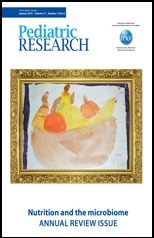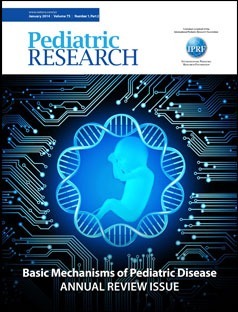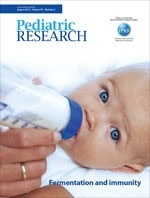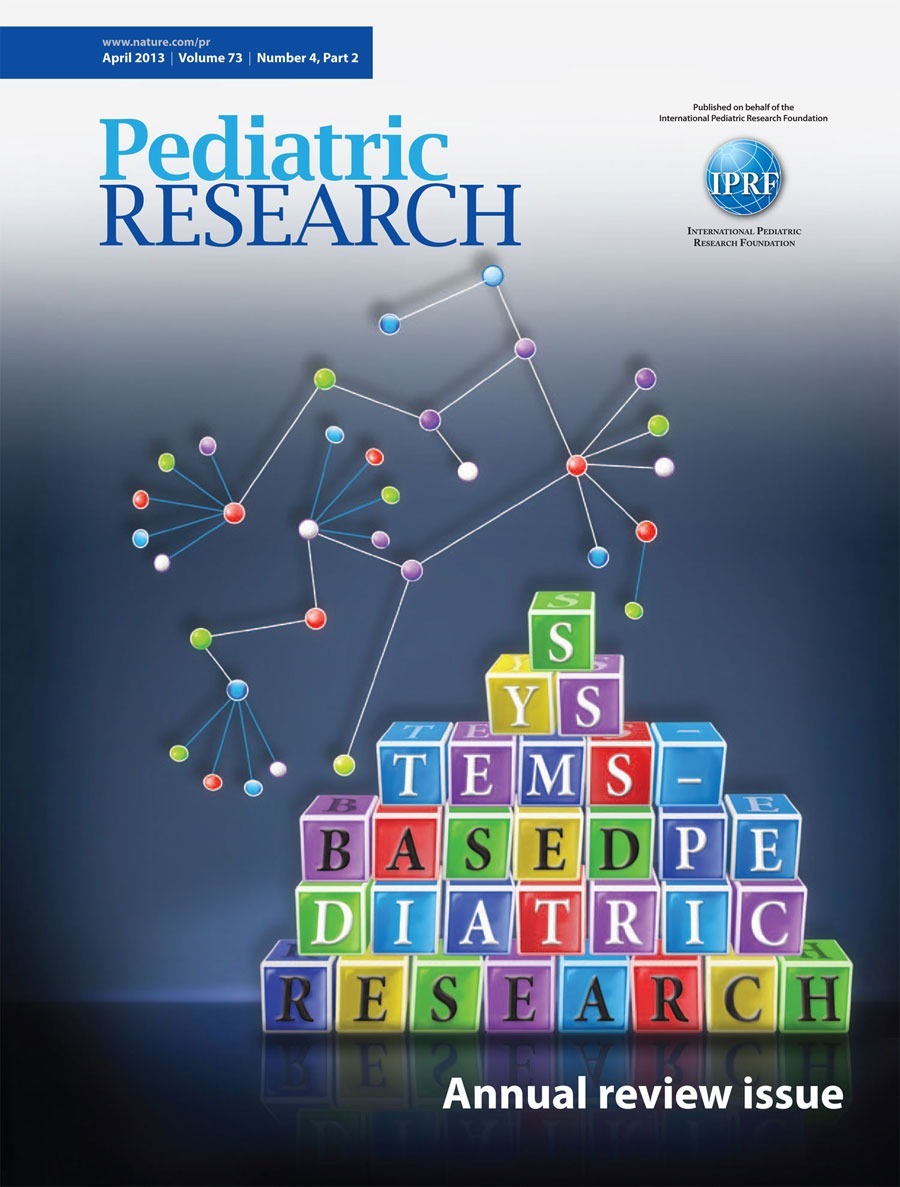| May 2015: Next Editorial Team Named by the International Pediatric Research Foundation
Cynthia Bearer, MD, PhD, and Eleanor Molloy, MD, PhD, have been appointed by the International Pediatric Research Foundation (IPRF) as the incoming Editor-in-Chief and Associate Editor-in-Chief, respectively, for Pediatric Research. Their terms will begin in January 2016. Dr. Bearer holds appointments as a Mary Gray Cobey Professor of Neonatology and Associate Chair for Research in the Department of Pediatrics at the University of Maryland School of Medicine in Baltimore, Maryland; Chief of the Division of Neonatology at the University of Maryland Hospital for Children in Baltimore; and as an adjunct professor in the Department of Pediatrics, Neurosciences and Environmental Health Sciences, Rainbow Babies and Children’s Hospital, Case Western Reserve University School of Medicine in Cleveland, Ohio. Additionally, she served as Chair of the Children’s Environmental Health Network, a national multi-disciplinary organization whose mission is to protect the developing child from environmental health hazards and promote a healthier environment. Dr. Molloy is Professor and Chair of Paediatrics, and Child Health Consultant Neonatologist and Paediatrician, at Trinity College, The University of Dublin, in Dublin, Ireland. Dr. Molloy is also affiliated with the National Children’s Hospital, The Adelaide and Meath Hospital in Dublin; Tallaght Coombe Women’s and Infant’s University Maternity Hospital, and Our Lady’s Hospital for Sick Children in Crumlin, Ireland. Dr. Molloy has served as an associate editor for the journal Archives of Diseases of Childhood. Her research is concerned with interdisciplinary child health research and the promotion of paediatric translational projects to improve child health. Specifically, she is interested in the evaluation and modulation of systemic inflammation in newborn infants with brain injury and the development of neonatal palliative care. |
| April 2015: 2015 Junior Author ‘Best Paper Travel Award’ Winners Named
The Editors of Pediatric Research and the Board of Trustees of the International Pediatric Research Foundation (IPRF) congratulate the 2015 winners of the Best Paper Travel Award for Junior Authors: Kristin Keunen, MD, in Utrecht, The Netherlands, and Shadi Malaeb, MD, in Philadelphia, Pennsylvania. Dr. Keunen coauthored a paper in Pediatric Research entitled, “Impact of nutrition on brain development and its neuroprotective implications following preterm birth” (doi:10.1038/pr.2014.171), which published in the January 2015 Review Issue focusing on Nutrition and the Microbiome. Dr. Keunen coauthored a paper in Pediatric Research entitled, “Impact of nutrition on brain development and its neuroprotective implications following preterm birth” (doi:10.1038/pr.2014.171), which published in the January 2015 Review Issue focusing on Nutrition and the Microbiome. The IPRF and the Editors of Pediatric Research encourage Dr Keunen and Dr. Malaeb to continue their important research, which supports the Journal’s mission of improving lives of children. |

|
Carlo Agostoni, MD, and Kwang Sik Kim, MD, served as the Guest Editors for this year’s Review Issue. In putting together the issue, the guest editors focused on the roles of nutrition and gut flora on infants’ and children’s health and disease. Inside the issue you’ll find more than twenty articles summarizing the critical roles that nutrition and gut flora play in infant and child health. Here are some of the key findings the issue covers:
On behalf of the Editors of Pediatric Research, we hope you enjoy perusing the content of this important supplemental issue of the journal. The Table of Contents and articles can be accessed at: https://www.nature.com/pr/journal/v77/n1-2/index.html. |
|
 |
Sherin U. Devaskar is the Guest Editor for the 2014 annual review issue of Pediatric Research, focusing this year on the Basic Mechanisms of Pediatric Disease (Vol. 75, No. 1-2 January 2014). The variety of review articles in this issue of Pediatric Research reflects the broad nature of pediatrics and is a hallmark of the journal. Mechanisms and pathobiology of disease should not be considered out-of-vogue, because it is the discovery of disease targets that paves the way for developing diagnostic tests and therapies. In the absence of knowledge regarding the mechanisms responsible for disease, therapies become nonspecific and risk the introduction of unnecessary side effects and therapeutic complications. The Table of Contents and articles for this issue can be accessed at: https://www.nature.com/pr/journal/v75/n1-2/index.html If you have problems accessing content, please email stephanie.dean@pedres.org. |
| October 2013 Winners of Pediatric Research Travel Award Announced
The Editors of Pediatric Research and the Board of Trustees of the International Pediatric Research Foundation (IPRF) congratulate the October 2013 winners of the Best Paper Travel Award for Junior Authors: Dawn Gano of the University of California San Francisco; and Robert Galinsky of the University of Auckland, Auckland, New Zealand. Dr. Dawn Gano was a co-author on a paper entitled “Evolution of pattern of injury and quantitative MRI on days 1 and 3 in term newborns with hypoxic-ischemic encephalopathy,” which appeared in the July 2013 issue of the journal. In the paper, Dr. Gano and her co-authors “describe the relationship between quantitative brain imaging parameters in term newborns with neonatal encephalopathy acquired on the first day of life to those obtained at 3 days of age, the ‘routine’ time for clinical scanning. Dr. Gano shows that, unlike conventional MRI, quantitative MRI tools can robustly detect injury as early as the first day of life,” according to Steven P. Miller, Head of the Division of Neurology at The Hospital for Sick Children in Toronto, Canada. Dr. Robert Galinsky was a co-author on “Intrauterine inflammation alters cardiopulmonary but not cerebral hemodynamics during open endotracheal tube suction in preterm lambs,” which appeared in the July 2013 issue of the journal. According to Alistair Gunn, Head of the Department of Physiology and Professor of Physiology and Paediatrics at the University of Auckland, this study used a challenging translational paradigm of intrauterine infection in pregnant sheep, followed by premature delivery and resuscitation. Dr. Galinsky and his co-authors found that exposure to intrauterine infection exacerbated the cardiopulmonary hemodynamic response to endotracheal tube suctioning. This important finding strongly suggests that reducing the frequency and hemodynamic impact of endotracheal tube suction would help to reduce the incidence and severity of cardiopulmonary hemodynamic instability in preterm infants. The IPRF and the Editors of Pediatric Research encourage Dr Gano and Dr. Galinsky to continue their important research, which supports the Journal’s mission of improving lives of children. |
Discussed in Review Article in August Pediatric Research |
|
 (Vol. 74, No. 2 August 2013)
|
August 2013: Granier, Goulet, and Hoarau explore the immunological effects of fermentation products in animal and humans in the August issue of Pediatric Research. This Integrated Mechanism Review article covers 55 studies involved in this area of research. As the authors note, a better understanding of fermentation products’ action at the gut and mucosal level may contribute to a better knowledge of mucosal immune maturation and to the necessary discussion regarding the use of infant formulae orientated to immunomodulation. Infant formulae have been shown to influence the development of the gut microbiota. Besides the probiotic- and prebiotic-containing formulae, fermented milk-based infant formulae offer an additional means for modulation of gut immunity and/or gut microbiota. This review focuses on the effects of fermentation products, distinguishing them from those of living bacteria and prebiotic compounds on the immune system. Besides possible modulation of gut microbiota composition, studies suggest that specific fermentation products can actively participate in the establishment of immune balance and oral tolerance. To read the full text of this article FREE, please go to:https://www.nature.com/pr/journal/v74/n2/pdf/pr201376a.pdf The full citation for this article is: |
 (Vol. 73, No. 4-2 April 2013) |
Parviz Minoo, PhD; Olaf Wolkenhauer, PhD; and Susan Guttentag, MD, are the Guest Editors for this annual review issue, focusing this year on systems-based pediatric research. The reductionist approach remains centerpiece in experimental research. This approach has been remarkably successful in identifying key functional components of life. However, living systems are immensely complex, relying not on individual components but rather on constellations of interacting networks, each of which is complex in its own right, composed of multiple components in perpetual interactions among themselves. Even on the basis of the reductionist approach, it is difficult to imagine a molecular or biochemical factor that acts in solo, disconnected from all other interactive factors. Therefore, there has been a growing need for a new way of thinking and experimentation to elucidate the multiple interactive systems contributing to the overall physiology of a living organism. The Table of Contents and articles for this issue can be accessed at: https://www.nature.com/pr/index.html If you have problems accessing content, please email stephanie.dean@pedres.org. |
|
The Editors of Pediatric Research and the Board of Trustees of the International Pediatric Research Foundation (IPRF) congratulate the April 2013 winners of the Best Paper Travel Award for Junior Authors: Stacey Ellery of Monash Institute of Medical Research, The Ritchie Center, Clayton, Victoria, Australia; and Niek van der Aa of Wilhelmina Children’s Hospital, University Medical Center, Utrecht, The Netherlands. Ms. Ellery was a co-author on a paper entitled “Creatine pretreatment prevents birth asphyxia-induced injury of the newborn spiny mouse kidney,” which appeared in the February 2013 issue of the journal. The paper is an important step in the literature about the possible prevention of organ injury from asphyxia. Dr. van der Aa was a co-author on “Quantification of white matter injury following neonatal stroke with serial DTI,” which will appear in the June 2013 issue of the journal. This paper provides information for clinicians that may assist in predicting motor and visual outcome in a group of at-risk infants. The technique that is used is novel and clearly visualizes the pathological changes following neonatal stroke. The IPRF and the Editors of Pediatric Research encourage Ms. Ellery and Dr. van der Aa to continue their important research, which supports the Journal’s mission of improving lives of children. |
